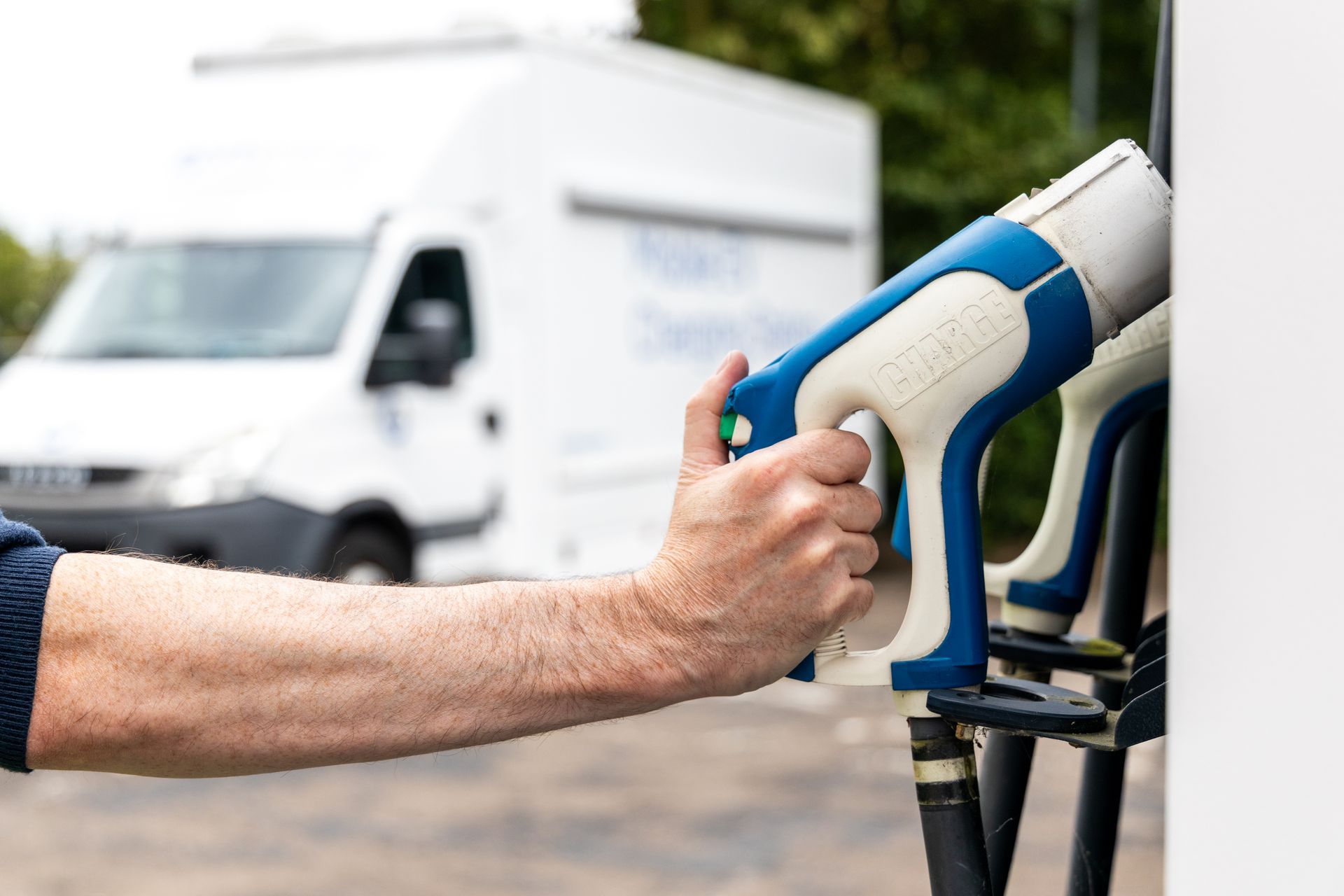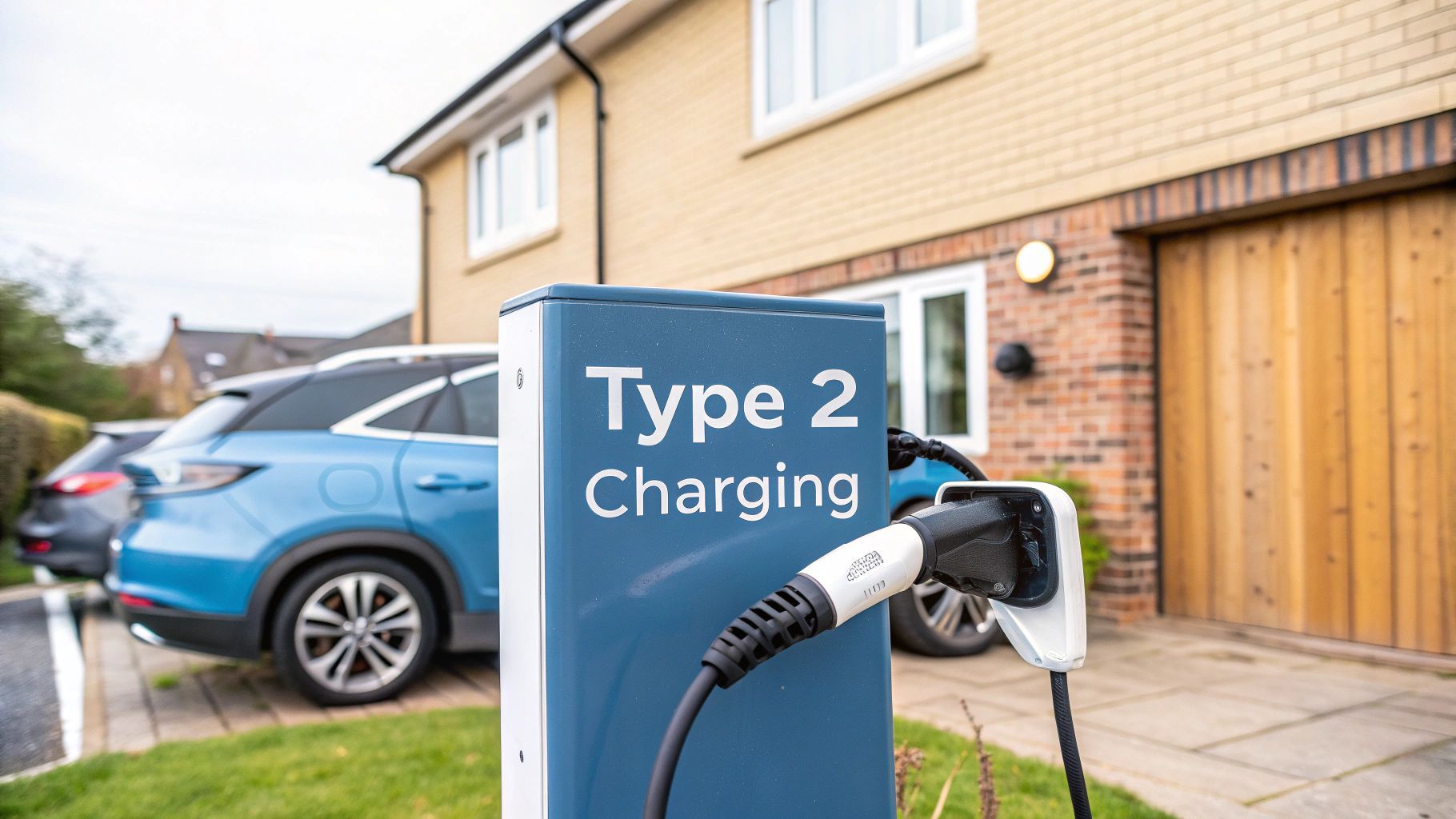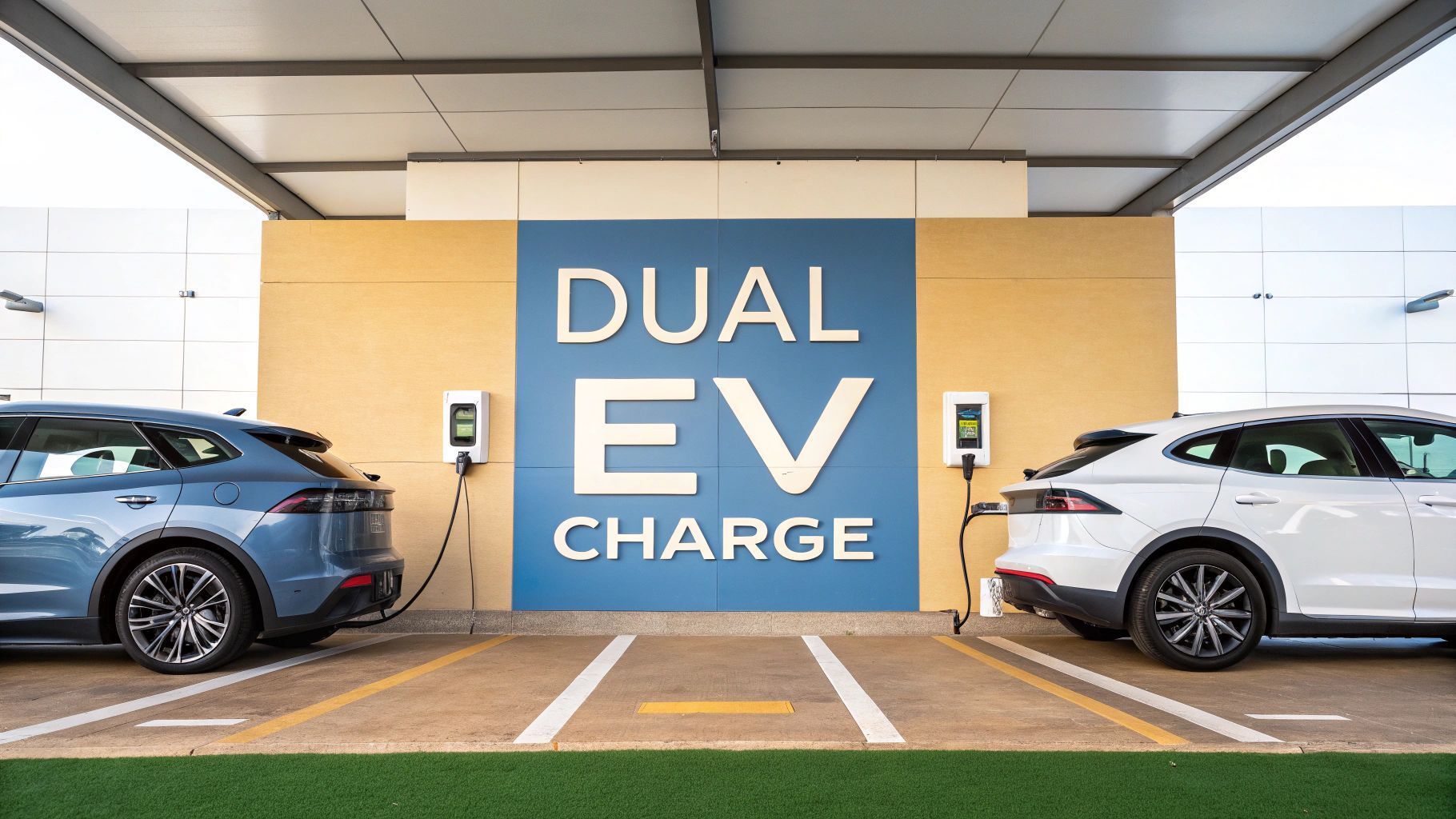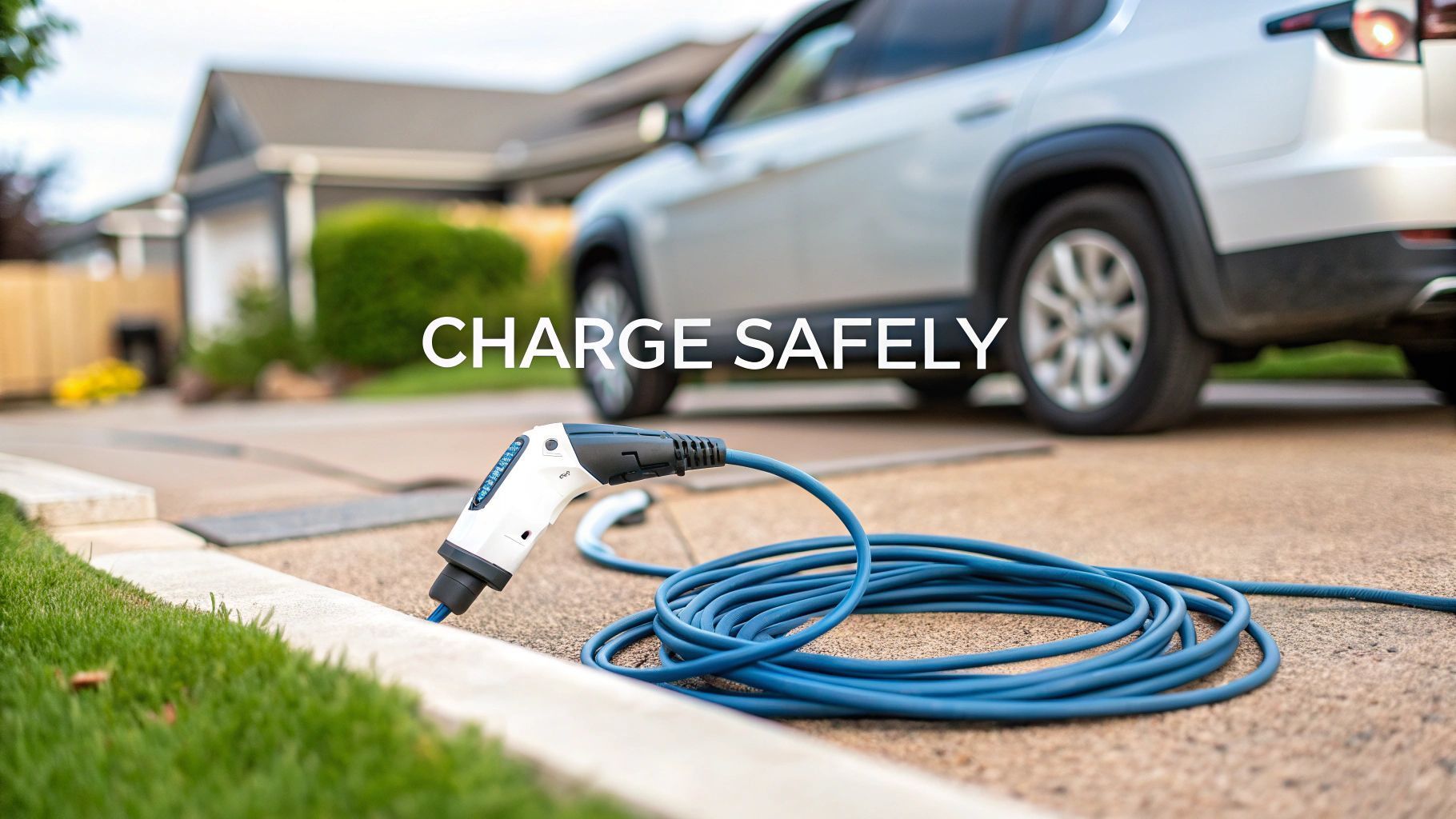A Guide to UK EV Fleet Management
So, what exactly is EV fleet management ? Think of it less like simple vehicle tracking and more like conducting an orchestra. It’s the art of strategically coordinating your electric vehicles to get the absolute most out of them, all while keeping costs down. This goes way beyond knowing where a van is on a map; we're talking about optimising charging schedules , keeping a close eye on battery health and using specialised software to tie everything together into one seamless operation.
Understanding Modern EV Fleet Management

Moving to an electric fleet isn't just a case of swapping petrol pumps for power plugs. It demands a much smarter, data-led way of thinking about your entire operation. For UK businesses, making this shift is becoming essential to stay competitive and compliant. The whole system really stands on four interconnected pillars that must work in harmony to create an efficient, resilient fleet.
The Four Pillars of a Successful Transition
A successful EV operation is built on getting a few key areas right from the start. Nail these and you're well on your way to building a fleet that’s truly future-proof.
- Strategic Vehicle Acquisition: This means picking vehicles based on the real-world demands of your routes and payload. It’s about looking at the total cost of ownership, not just the sticker price.
- Resilient Charging Infrastructure: You need a smart mix of depot, public and flexible mobile charging. The goal is simple: keep your vehicles energised and eliminate operational downtime.
- Powerful Management Software: A central platform is your command centre. It’s where you monitor vehicle health, schedule charging to hit off-peak energy rates and map out the most efficient routes.
- Driver Training and Empowerment: Your drivers are on the front line. Teaching them skills like regenerative braking and smart charging habits can dramatically extend a vehicle's range and the lifespan of its battery.
The pressure is on for UK businesses to get this right. The government is aiming for 80% of new cars and 70% of new vans sold in Great Britain to be zero-emission by 2030. To get there, it’s vital to understand the fundamentals of modern fleet management best practices.
The Accelerating Pace of Adoption
UK businesses aren't waiting around; they're electrifying their fleets at a remarkable speed. In 2024 alone, businesses put around 64,000 more battery-electric vehicles on the road than they did the previous year.
This isn't a trend on the horizon—it's happening right now. Early adopters are already seeing a real competitive edge and you can learn more about how ZAPME is helping companies make the switch by reading about revolutionising fleet management for uninterrupted operations.
The Core Components of an EV Fleet Ecosystem
A successful electric fleet isn't just about the vehicles. It operates like a finely tuned machine, with every part working together seamlessly. To get there, you need a few essential technologies to create a powerful ecosystem that keeps your vehicles charged, tracked and running as efficiently as possible.
This simple infographic breaks down the core pillars of a modern EV fleet.
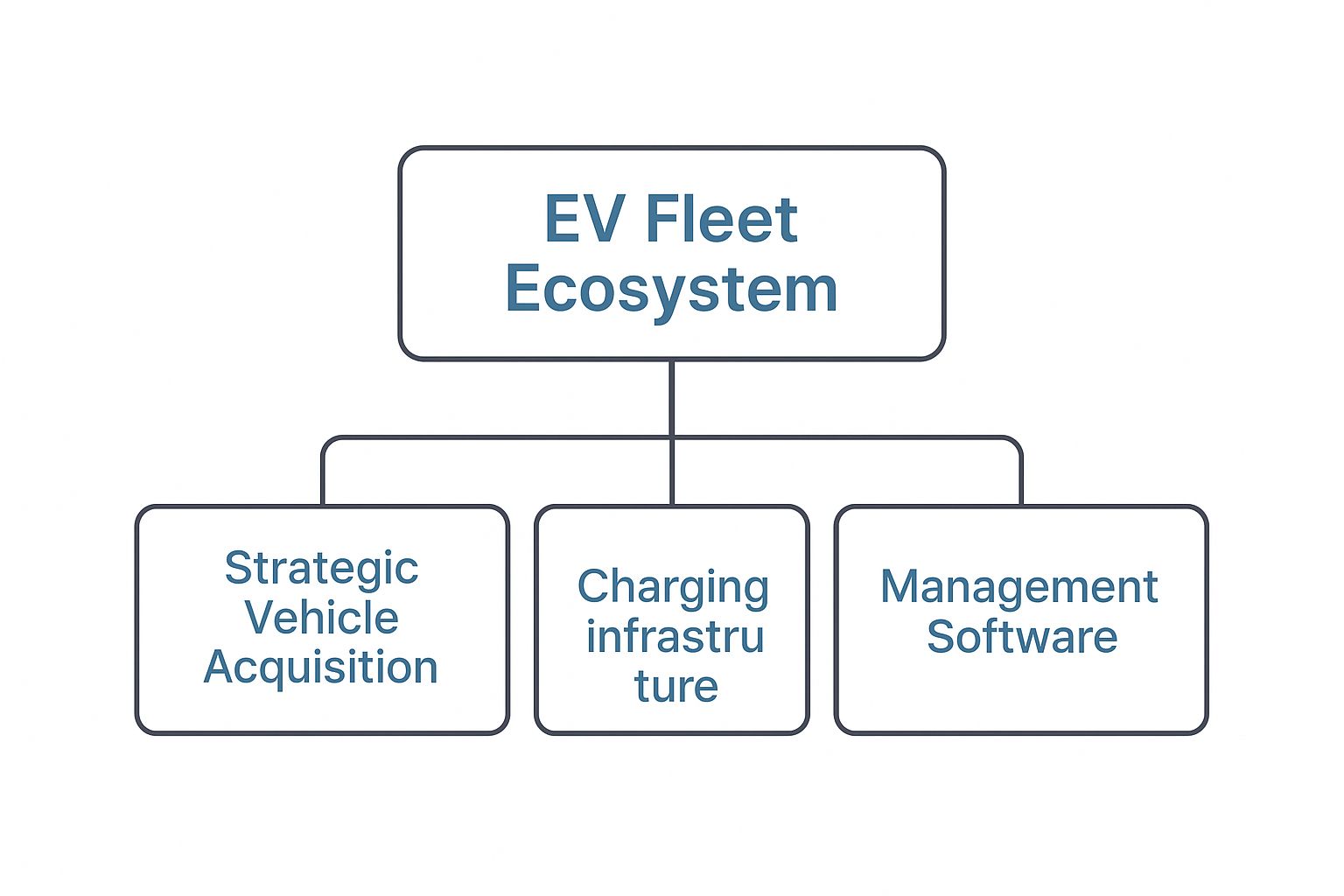
As you can see, a strong ecosystem is all about balance. It’s not just about picking the right vans or lorries; it’s about having the right infrastructure and software to back them up. Let's dig into what each of these pieces of the puzzle actually does.
Resilient Charging Infrastructure
First up and arguably the most fundamental component is your charging infrastructure. This is the lifeblood of any electric fleet and it's definitely not a one-size-fits-all situation. A smart strategy will mix and match different charging types to guarantee vehicles are always ready to go, keeping operational downtime to an absolute minimum.
There are three main ways to get power into your fleet:
- Depot Charging: This is your home base, where vehicles typically charge overnight. It's reliable for sure but can come with a hefty price tag for grid upgrades and charger installation.
- Public Charging Networks: These offer a bit of freedom for vehicles on long-haul routes or for those that do not have a regular return-to-base schedule. The catch? Relying on public stations can be a lottery when it comes to availability and cost.
- Mobile On-the-Go Charging: This is the flexible option that brings the charger directly to the vehicle, wherever it's parked. It’s a game-changer for cutting out wasted time searching for charging points and can be a brilliant stop-gap to sidestep those costly depot upgrades.
By blending these options, you create a charging network that’s both dependable and cost-effective, giving your EV fleet management plan a solid foundation to build on.
Telematics and Vehicle Tracking
The second piece of the puzzle is telematics . Think of it as the nervous system of your entire operation, sending vital data from your vehicles back to a central hub. Using GPS trackers and onboard diagnostics, telematics technology gives you a constant stream of information.
And this data is so much more than just a dot on a map. It delivers crucial insights into:
- Battery State of Charge (SoC): Knowing the exact energy level of every single vehicle allows for smarter dispatching and sends out proactive alerts when a top-up is needed.
- Driver Behaviour: You can monitor things like harsh braking or sharp acceleration, which helps you spot opportunities for driver training to improve energy efficiency and safety.
- Vehicle Health: Real-time diagnostics can flag potential maintenance issues before they turn into major headaches, saving you a fortune on repairs and vehicle downtime.
When you put these technologies to work, you get real, measurable results. The 2025 Fleet Technology Trends Report found that 63% of UK fleets using these kinds of solutions saw improved productivity and 59% reported better customer service. It’s clear proof that data-driven decisions are the key to succeeding with a modern fleet.
Intelligent Management Software
Finally, you need a brain to make sense of all this data. That’s where the third component, management software , comes in. This platform acts as your command centre, turning all that raw telematics data into actionable intelligence that drives efficiency and brings costs down.
The right software doesn't just show you what your fleet is doing; it tells you what it should be doing next. It transforms reactive problem-solving into proactive operational planning.
This software automates and optimises a whole host of critical tasks. For instance, it can analyse energy tariffs to schedule charging during the cheapest off-peak hours, saving a significant amount on your electricity bills. It also optimises routes based on traffic, terrain and battery levels to make sure jobs are completed using the least amount of energy.
The system even automates maintenance scheduling based on actual vehicle usage, ensuring your fleet stays healthy and reliable. To see how central data management has become for modern fleets, this Fleetio Case Study is well worth a read.
To tie it all together, here’s a quick breakdown of how these technologies work together to create a cohesive system.
Key Technologies in EV Fleet Management
| Technology Component | Primary Function | Key Benefit |
|---|---|---|
| Charging Infrastructure | To provide reliable energy to the vehicles. | Ensures operational readiness and minimises downtime. |
| Telematics Hardware | To collect real-time data from vehicles. | Delivers visibility into vehicle health, location and driver behaviour. |
| Management Software | To analyse data and automate decisions. | Optimises charging schedules, routes and maintenance for maximum efficiency. |
When these three components are integrated properly, they create a powerful feedback loop. The software uses data from the telematics to make smart decisions about charging, which in turn keeps the fleet moving and generating more data. It’s a virtuous cycle that leads to a smarter, cheaper and more reliable operation.
How Mobile Charging Unlocks Fleet Profitability

While depot and public charging are the go-to strategies for many fleets, they aren't without their headaches. The steep cost of installing depot chargers and the hit-or-miss reliability of public networks can throw a real spanner in the works. This is where mobile EV charging steps in, offering more than just convenience—it’s a direct path to greater flexibility and a surprisingly powerful new revenue stream.
By bringing the charger directly to the vehicle, you completely sidestep the wasted time drivers spend hunting for a working charge point. Vehicles get topped up wherever they happen to be—a job site, a driver's home or a remote depot without any fixed infrastructure. This flexibility not only avoids the huge capital spend on grid upgrades and installations but also flips a potential cost centre into a genuine profit-generator.
Transforming Downtime into Revenue
The most persuasive case for mobile charging is the financial one. A mobile charging unit doesn't just have to support your own fleet; it can become a business in its own right. Fleet operators can generate serious income by offering charging services to other local businesses and even the public, creating a profitable venture from what was once just an operational necessity.
Think about it: your delivery vans might charge overnight, leaving your mobile unit free to serve other businesses during the day. This dual-purpose strategy means the unit not only pays for itself but quickly becomes a consistent source of profit.
Mobile charging completely reframes the energy conversation. Instead of asking, "How much will charging cost my fleet?" the question becomes, "How much revenue can my charging service generate?"
This shift in mindset is the key to unlocking the full financial potential of your EV fleet management system. You’re no longer just managing vehicles; you're managing a mobile energy service with real value to a wide range of customers.
Calculating Your Earning Potential
The profitability of a mobile charging service is built on a smart mix of direct charging fees and other value-added services. By setting up a clear pricing structure, you can build a reliable and scalable income. Let's break down the main ways to make money.
A successful mobile charging business model has several layers:
- Per-kWh Pricing: This is the most straightforward part. You buy electricity at one rate and sell it at a healthy margin. A typical profit margin might be between £0.15 and £0.25 per kWh .
- Call-Out or Service Fees: Every charging session should include a fixed fee. This covers the logistics of getting the charger to the client and ensures every single job is profitable, no matter how much energy is delivered.
- Subscription Models: For regular clients, you can offer monthly or annual contracts. These provide a set number of charging sessions or kWh for a fixed price, creating predictable, recurring revenue you can count on.
Combining these elements gives you a robust financial model. For a deeper dive into the nuts and bolts of this business model, our UK mobile EV charging service guide offers detailed insights and strategies.
A Realistic Earnings Scenario
To show you what’s possible, let’s walk through a realistic scenario for a single mobile charging unit.
Imagine an operator with a 100kWh mobile unit. They decide to offer a 'charge-at-work' service to local businesses that have not installed their own chargers yet. Their pricing is simple: a £10 call-out fee per vehicle, plus a £0.20 profit margin on every kWh delivered.
On a typical day, the operator visits a small business park and charges 10 vehicles , delivering an average of 30kWh to each one.
Here’s how the daily earnings stack up:
| Revenue Stream | Calculation | Daily Total |
|---|---|---|
| Call-Out Fees | 10 vehicles x £10 fee per vehicle | £100 |
| Energy Profit | 300 kWh total x £0.20 profit/kWh | £60 |
| Total Daily Revenue | £100 + £60 | £160 |
That’s £160 per day from just one unit. If the service runs five days a week, the monthly revenue is around £3,200 . Annually, that scales to over £38,400 from a single mobile charger operating during normal business hours.
Scaling and Diversifying Your Service
The real power of this model is its scalability. You're not just limited to one type of client; new revenue opportunities are everywhere.
You can quickly expand by exploring:
- B2B Contracts: Secure lucrative contracts with other logistics firms, last-mile delivery services or construction companies that need on-site charging for their own electric vans and equipment.
- Emergency Roadside Assistance: Partner with breakdown services to offer emergency top-ups for stranded EV drivers. This is a premium service that can command much higher fees.
- Event Charging: Provide temporary charging for festivals, outdoor concerts and corporate events, filling a massive gap in these pop-up environments.
- Residential Charging Solutions: Offer services to apartment blocks or housing estates where installing permanent chargers is either too complex or too expensive.
By branching into these areas, a fleet operator can build a multi-faceted mobile energy business. A small fleet of just three or four mobile units could easily generate a six-figure annual revenue, turning charging infrastructure from a necessary evil into a core part of the business's profitability. This is what forward-thinking EV fleet management looks like.
Navigating the UK's EV Adoption Landscape
Successfully shifting a fleet to electric in the UK isn't just about choosing the right vehicles. It demands a sharp understanding of the local environment. EV adoption isn’t a single, uniform story across the country; it’s a complex patchwork of regional progress and localised roadblocks. For any fleet manager, recognising this diversity is the first step toward building a strategy that actually works on the ground, not just on paper.
A one-size-fits-all approach to EV fleet management is almost guaranteed to fail because conditions can change dramatically from one city to the next. Things like local government incentives, the density of public chargers and specific clean air zone policies create a unique operational landscape in each area. This means a brilliant strategy in Bristol might completely fall flat in London.
The Great EV Divide Across UK Cities
The uneven nature of fleet electrification is stark when you look at the numbers. There's a clear divide in EV fleet adoption across the UK’s major urban hubs.
Data gathered through Freedom of Information requests to city councils shows that Bristol is leading the charge, with EVs making up a massive 44.5% of its local authority fleet. Liverpool is right behind at 43.3% .
In contrast, cities like Leeds ( 27.8% ), Manchester ( 26.8% ) and Glasgow ( 25.8% ) show more modest, though still significant, progress. Perhaps the biggest surprise is London, where Transport for London (TfL) reported that just 3.2% of its heavy goods vehicles and vans are electric—a figure that stands out against other major UK cities. You can explore more about these findings to get a better handle on the regional differences.
This data highlights a critical point for any national fleet operator: your decisions on vehicle deployment and charging strategy have to be tailored to the specific opportunities and hurdles of each geographic area you operate in.
Why Do These Regional Differences Exist?
The gap between cities isn’t an accident. It’s driven by a combination of proactive local policies and targeted investment. Cities like Bristol and Liverpool have benefited from forward-thinking local authorities that have actively championed electrification.
Several key factors are creating this 'EV divide':
- Local Government Incentives: Some councils offer grants, cheaper parking or exemptions from local charges for electric commercial vehicles, which directly improves the business case for making the switch.
- Public Charging Investment: Areas with more reliable and accessible public chargers give fleet operators the confidence to run EVs without constantly worrying about range.
- Specific Regional Policies: The strictness of Clean Air Zones (CAZs) or Low Emission Zones (LEZs) can force businesses to electrify their local local fleets much faster.
For fleet managers, the lesson is clear: a successful national electrification strategy is actually a collection of well-executed local ones. It's about adapting to the specific ecosystem of each city rather than imposing a rigid, top-down plan.
By carefully analysing these regional factors, fleet managers can gain powerful strategic insights. This allows for a much more nuanced approach, where investment in charging infrastructure and vehicle allocation is funnelled into areas offering the best conditions for success. Understanding this landscape is fundamental to effective EV fleet management .
A Practical Guide to a Seamless Fleet Transition

Making the move to an electric fleet can feel like a mammoth task. But if you break it down with a clear, methodical plan, it becomes a much more manageable process. A successful transition isn't about diving in headfirst; it's a series of deliberate steps designed to minimise disruption, control costs and make sure your electric vehicles deliver from day one.
This practical guide breaks down the journey into four key stages. Following this framework will help you sidestep the common pitfalls and build a resilient, efficient electric fleet that's ready for the future.
Start with a Thorough Fleet Audit
Before you even think about buying a single vehicle, you need to understand your existing operation inside and out. A fleet audit is the essential first step. It means digging into your current vehicle usage data to pinpoint the best candidates for your initial phase of electrification. Not every route or vehicle is a perfect fit for an EV right away.
The goal here is to find the low-hanging fruit. Look for vehicles with predictable daily routes that are well within the range of modern electric vans and that return to a central depot each day. This data-led approach removes guesswork and sets your first EVs up for success, creating positive momentum for the rest of the transition.
Develop a Strategic Charging Plan
Once you know which vehicles to switch, you need a rock-solid plan for keeping them energised. Effective EV fleet management relies on a charging strategy that is both resilient and flexible. Putting all your eggs in one basket is a risky move; a blended approach is the key to maximising vehicle uptime and keeping your operations running smoothly.
Your charging mix should ideally include:
- Depot Charging: The backbone for most fleets, providing reliable overnight power when vehicles are idle.
- Public Network Access: Essential for drivers on longer routes or for vehicles that do not return to base every night.
- Mobile Charging: The flexible friend that brings power directly to your vehicles, eliminating downtime and supporting operations in areas without fixed infrastructure.
This mix ensures you have the right tool for every job. To help clarify the distinct roles of depot versus mobile charging, here’s a quick comparison.
Stationary Depot Charging vs Mobile On-Demand Charging
The choice between fixed and mobile charging isn't always an either/or decision. They often serve different, complementary purposes within a smart fleet strategy. Understanding their core differences is key to building a robust charging plan.
| Feature | Depot Charging | Mobile Charging (e.g. ZAPME) |
|---|---|---|
| Location | Fixed at a specific depot or property. | Fully mobile; can be deployed anywhere needed. |
| Installation | Requires significant upfront investment, planning and often costly grid upgrades. | No installation needed. Ready to use upon arrival. |
| Flexibility | Inflexible. Vehicles must return to the depot to charge. | Extremely flexible. Brings the charger to the vehicle, saving time and fuel. |
| Scalability | Scaling up is expensive and slow, requiring more construction and grid work. | Easily scalable by adding more mobile units to the fleet as your needs grow. |
| Ideal Use Case | Predictable overnight charging for return-to-base fleets. | Emergency top-ups, field charging and avoiding high depot installation costs. |
Ultimately, depot charging provides a reliable foundation for daily operations, while mobile charging offers the agility to handle unexpected needs and fill infrastructure gaps, ensuring your fleet is never left powerless.
Prioritise Driver Training and Engagement
Your drivers are absolutely crucial to the success of your electric fleet. Without their buy-in and understanding, even the best technology will underperform. Proper training isn't just a suggestion; it's a necessity for getting the most out of your expensive new assets.
Your drivers are the single biggest variable in determining a vehicle's real-world range. Investing in their training delivers a direct and immediate return through improved efficiency and lower energy costs.
Training should cover the key techniques that squeeze every last mile out of the battery. This includes teaching the principles of regenerative braking, which can recover a surprising amount of energy. It also means explaining charging etiquette to ensure fair use of shared facilities and showing them how to find and use different types of chargers out on the road.
Leverage Data to Continuously Improve
The switch to electric isn't a one-and-done project. It's an ongoing process of refinement and optimisation. The telematics data your new EV fleet generates is an incredibly valuable resource for making constant improvements to your operation.
By analysing this data, you can fine-tune every aspect of your EV fleet management . For example, you can adjust routes based on real-world energy consumption, identify drivers who might need a bit more coaching and even predict maintenance needs before they become serious problems. This feedback loop—of data informing action—is what turns a good electric fleet into a great one.
Common Questions on EV Fleet Management
Stepping into the world of electric fleets always brings up a lot of practical questions. To round off this guide, we’ve put together some of the most common queries we hear from fleet managers as they plan their transition. The aim is to give you clear, straightforward answers so you can make decisions with confidence.
How Much Can a Mobile EV Charger Operator Realistically Earn?
This is one of the most interesting parts of running a mobile charging operation and the answer often comes as a pleasant surprise. The earning potential goes far beyond just supporting your own fleet; it can easily become a strong, independent revenue stream on its own. The model is simple but very effective: you combine service fees with a healthy margin on the energy you sell.
Let's look at the numbers. A mobile unit creates income in two main ways: a profit on each kilowatt-hour (kWh) delivered and a fixed call-out fee for the job. Say one of your mobile units delivers 300 kWh in a single day. With a conservative profit margin of just £0.20 per kWh , that’s £60 in energy profit right there.
Now, imagine that energy was delivered to 10 different vehicles and you charged a modest £10 service fee for each. That adds another £100 to the day's takings, bringing the total daily revenue for that one unit to £160 . If you operate five days a week, that single unit could generate over £3,200 a month . It shows just how quickly the service can scale into a profitable business.
Beyond that, you can build even more stable income through B2B contracts with local businesses—think delivery firms, construction sites needing on-site power or even event organisers. By diversifying your client base, you can build a highly profitable and resilient mobile charging business.
What Is the Biggest Hidden Cost When Transitioning a Fleet to EVs?
While buying the vehicles is the most obvious expense, the biggest—and often most shocking—cost is upgrading the electrical infrastructure for depot charging. Many commercial properties, particularly older ones, simply do not have the grid capacity to handle multiple high-power fast chargers running at the same time. This is a critical factor in EV fleet management that gets overlooked far too often in the early planning stages.
Bringing in the necessary power can mean extensive and costly work with the local Distribution Network Operator (DNO). The process might require new substations, digging trenches for bigger cables and navigating significant planning permissions.
A DNO grid upgrade can easily run into the tens of thousands of pounds and in some cases, can soar past £100,000. These projects can also introduce delays of many months, seriously disrupting a fleet's transition timeline.
This is exactly why getting a thorough site survey done early is non-negotiable. You have to understand your site's electrical limitations from day one. Mobile charging can play a huge role here, either as a stop-gap to get your first EVs on the road while you wait for grid upgrades or as a permanent solution to put off those high capital costs indefinitely.
How Does Cold Weather Affect EV Fleet Performance?
Cold weather definitely has an impact on EV performance and it’s vital to have a strategy to manage it. The main effects are a drop in battery range—which can be as much as 30-40% in really harsh winter conditions—and slower charging speeds. This all comes down to chemistry; the reactions inside the battery are simply less efficient at lower temperatures.
The good news is that fleet managers can fight back with a few practical strategies:
- Precondition Your Vehicles: This means warming up the battery and cabin while the vehicle is still plugged in. It uses power from the grid, not the battery, so you start the day with a warm van and a full charge.
- Encourage Smart Heating: Tell your drivers to use the heated seats and steering wheel instead of blasting the main cabin heater. These systems use far less energy and can make a noticeable difference to the vehicle's range.
- Adjust Route Planning: Your management software should be updated to account for the reduced winter range. This stops drivers from being caught short and keeps your schedules realistic.
By putting these simple measures in place, you can make sure your fleet stays reliable and efficient, even when the temperature plummets.
Can I Mix Different EV Manufacturers in One Management System?
Yes, absolutely. This is a common worry for managers who want the freedom to pick the best vehicle for the job, no matter the badge on the front. Modern EV fleet management software is designed to be hardware-agnostic, which means it can talk to vehicles from a huge range of manufacturers. If you want to get a better handle on the units of energy involved, you can learn how to calculate a kilowatt-hour in our detailed guide.
This works through telematics devices that plug into a vehicle's standard onboard diagnostics (OBD-II) port. These little gadgets pull data directly from the vehicle’s systems and send it back to your central software platform. This lets you monitor location, battery state of charge, energy efficiency and driver behaviour for your entire fleet on one single dashboard.
This capability is essential for running a modern fleet. It means you can have a mix of vehicles from Ford, Renault, Mercedes and others, all managed seamlessly through one system. You're not locked into a single manufacturer's ecosystem, giving you the freedom to build a fleet that truly works for your business.
Ready to eliminate charging downtime and unlock new revenue streams? The team at ZAPME is here to help you build a flexible, profitable and future-proof charging strategy with our leading mobile solutions. Explore our services and discover how we can energise your fleet today at https://www.zapme.biz.

